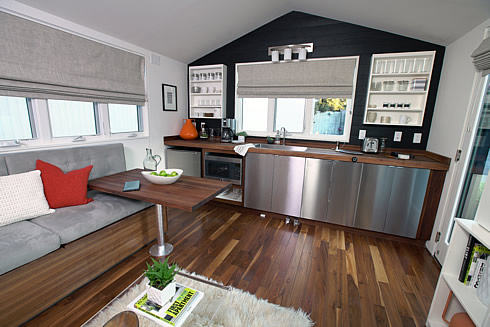
Intel Introduces Smart Tiny House Concept For IoT Connected Devices
To explore the possibilities that the Internet of Things holds for the home, Intel built a tiny, connected home to serve as a "living lab." The home, an experimental showcase that Intel will develop over the next 12 to 18 months, demonstrates the company’s intention to address key issues - from interoperability to security to actionable data outputs – and provide the hardware, software and power of the cloud to take the home from "connected" to "smart."
Thanks to the Internet of Things (IoT), homes and the world at large are becoming a collective intelligence of enormous capability and increased complexity. To advance, the industry must work together to future-proof the infrastructure supporting the smart home. Intel plans to workacross the expanding ecosystem to aid the transition from a series of connected point devices to a fully integrated smart home.
As the home moves from connected to smart, this technology will enable a new breed of consumer electronic devices – everyday things such as light bulbs, thermostats, smoke detectors, electrical outlets and cameras -to become connected and smart. These tiny brains inside "things" throughout the home will compute and produce data at the device level for real-time intelligence.
Intel-based gateways connect the home’s smart devices, providing analytics and storage, allowing the home, people and devices to work together in an intelligent fashion.
Intel has developed the Intel Smart Home Development Acceleration Platform to connect "things" in the home. It was created to overcome immediate operability issues that arise between connected devices, technology platforms and third-party service providers. The kit, optimized for Intel processors, supports and manages development environments for a range of capabilities and compute needs – from basic hub s to connecting devices to advanced home controllers that provide audio, video and voice analytics – helping developers build and deploy new apps while ensuring compatibility across OS updates.
The Development Acceleration Platform will be showcased in the home and will be available in Q1 2016.
The intention is for the Intel smart tiny home to go beyond the four walls of the home to incorporate all of your smart and connected devices, such as new smart watches and bracelets from Fossil, the Basis Peak Titanium and Recon Instruments Goggles, as well as sleek compute devices, such as the Lenovo Horizon 2 All-in-One PC, that are incorporated into the tiny home.

Intel’s vision is to make the home of the future connected and smart via a single app interface that enables homeowners to control all the home’s devices in one place across a variety of device and sensor manufacturers.
Utilizing open standards, such as the Open Interconnect Consortium, Intel has enabled interoperability between distinct lighting solutions: Philips Hue, Cree and Osram. Despite each light’s propriety connectivity protocols, the app can recognize each light and allows them to work together, thanks to the established interoperability.
Security is a primary homeowner concern, and the smart tiny home features technologies that allow for peace of mind, whether homeowners are just around the corner or thousands of miles away.
Remote locking and the ability to remotely control and monitor devices, such as lights and motion sensors, provides users the security they crave. TrueKey by Intel Security facial recognition technology provides hands-free security when you arrive home; allows access to trusted friends and neighbors when you’re not home; and alerts you of suspicious activity when you may not be looking. The home goes into away mode, turning off lights and locking the door, when no occupant presence is detected. The home automation is a lso capable of detecting when glass breaks or a smoke alarm is triggered, and could even be programmed to alert to the sound of a crying baby.
Using pattern recognition algorithms and Intel’s API management solution,
the Intel Smart Home Development Acceleration Platform provides a "things" to cloud solution that recognizes a problem, anticipates a need and provides a solution to the homeowner.





















